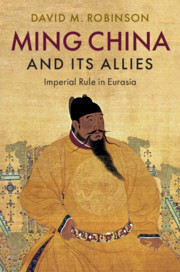Book contents
- Ming China and Its Allies
- Ming China and Its Allies
- Copyright page
- Dedication
- Contents
- Maps
- Acknowledgments
- Abbreviations
- Introduction
- 1 March to Power in a Chinggisid World
- 2 Search for Control
- 3 Mongol Nobles at the Ming Court
- 4 The Struggle for the Chinggisid Legacy
- 5 Allies and Commensurability
- Conclusion
- Bibliography
- Index
2 - Search for Control
Published online by Cambridge University Press: 10 December 2019
- Ming China and Its Allies
- Ming China and Its Allies
- Copyright page
- Dedication
- Contents
- Maps
- Acknowledgments
- Abbreviations
- Introduction
- 1 March to Power in a Chinggisid World
- 2 Search for Control
- 3 Mongol Nobles at the Ming Court
- 4 The Struggle for the Chinggisid Legacy
- 5 Allies and Commensurability
- Conclusion
- Bibliography
- Index
Summary
Chapter Two explores how court officials tried to come to terms with Zhu Di’s deep engagement with the steppe and its leaders. Zhu Di’s five steppe campaigns were more than military conflicts. Zhu Di visited the sites – sometimes ruins – of former Yuan palaces and lodges. He offered commentary on the Yuan ruling house, which accentuated his status as successor to the Great Yuan and as a ruler uniquely qualified to pass judgment on fellow sovereigns. Zhu Di’s actions challenged civil officials in many ways. They had to praise a sovereign who openly flouted the founder’s precedents. They celebrated the emperor’s newest subjects, men who drank blood, consumed raw liver, and exulted in physical strength. Court ministers’ writings depicted a style of rulership obviously connected to men from afar in ways that simultaneously satisfied their sovereign’s demands and minimized dangers to the polity and to themselves.
Keywords
- Type
- Chapter
- Information
- Ming China and its AlliesImperial Rule in Eurasia, pp. 58 - 87Publisher: Cambridge University PressPrint publication year: 2020

